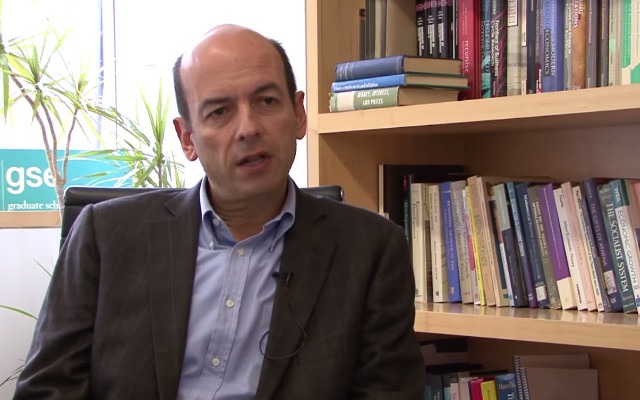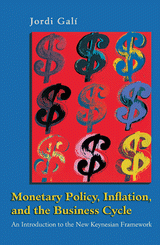faculty
Research Video: New Keynesian insights on wages, aggregate demand and unemployment

BSE Research Professor Jordi Galí is Director of CREI (Center for Research in International Economics), one of the GSE's academic units, and Professor at UPF and BSE. In 2012, he served as President of the European Economic Association. In his presidential address to the association, Professor Galí discussed new insights on wages, aggregate demand and employment based on the New Keynesian model. These insights have important implications for policy makers and central banks, which Prof. Galí outlines in the latest installment of the BSE Research Spotlight Video Series.
Simulations show that the impact of wages on unemployment is indirect
In order to conduct his research, Prof. Galí sets up a New Keynesian model and performs simulations that shed some light on the role that wages can play in increasing or decreasing unemployment.
"The first simulation involves a sudden unexpected reduction in payroll taxes—the kind of policy intervention that many institutions are calling for today," Prof. Galí says. "If the central bank's adjustment of interest rates in response to a lower inflation generated by lower payroll taxes is mild or weak, there is hardly any effect on aggregate demand and hence on employment. Only if the central bank responds aggressively by lowering the interest rate substantially will the reduction in the payroll tax have a significant effect on employment.
The nature of the central bank's response to developments in the economy is crucial in determining the impact that changes in wages will have on employment.
"A second exercise that I carry out in this project involves varying the degree of wage flexibilities. The question that I want to ask myself is under what conditions a reduction in wage rigidities or an increase in wage flexibilities will be desirable. The answer to that question is not unconditional. It depends very much on how the central bank responds, once again. In particular, if the central bank is very aggressive in responding to changes in inflation, an increase in wage flexibility tends to make employment much more stable and has little or limited effects on the volatility of wages and the volatility of inflation. So there is an ambiguous improvement in welfare. However, if the central bank for whatever reason does not respond strongly to changes in inflation, an increase in wage flexibility, perhaps in a counter-intuitive way, may actually reduce welfare.
"These simulations show that wages by themselves do not have a direct impact on employment," Prof. Galí explains. "Their impact is only indirect through the effects that they have on inflation and the response of the central bank to changes in inflation. The nature of the central bank's response to developments in the economy is crucial in determining the impact that changes in wages will have on employment."
The open economy, central bank constraints, and household consumption: aspects for future research
Professor Galí points out that there are some factors that Keynes did not stress and which his current project does not take into account. These are aspects that will need to be taken into account in future research.
"One of these aspects is the open economy channel, through which wage adjustments may be helpful in fighting unemployment," Prof. Galí says. "If workers accept lower wages to the extent that this is reflected in prices, that will make domestic firms more competitive in world markets, and that will increase aggregate demand through exports. This then would hopefully lead to higher employment."
Other aspects can work in the opposite direction. For example, in certain circumstances, such as the case of a currency union or when the central bank has hit the zero lower bound, where interest rates are already zero, the central bank will not be able to respond by lowering interest rates. Both of these cases would mean result in wage reductions having no effect on aggregate demand, and therefore no gains in terms of employment.
The analysis of Keynes and the lessons that we can draw from revisiting that analysis using modern tools may call into question the macro benefits of wage flexibility, especially in terms of their potential role for stabilizing employment.
"A second factor that one needs to take into account is the fact that, as a large amount of evidence in the literature points to, a fraction of households are subject to borrowing constraints. That is, they do not have access to or do not use regularly financial markets in order to smooth their consumption. So essentially what they do is to consume all their labor income. What happens if wages are lowered? Those households' labor income will be reduced, their consumption will come down, and that will reduce aggregate demand further and may actually have a negative or adverse impact on employment, contrary to what was intended," Prof. Galí explains.
Analysis using modern tools illustrates micro versus macro benefits of wage flexibility
Professor Galí reflects that Keynes' thinking on the role of wages in the adjustment of labor markets is quite enlightening in the current economic situation. "I think there are many reasons to believe that flexible labor markets and flexible wages may be desirable, but those reasons are largely microeconomic. I think that the analysis of Keynes and the lessons that we can draw from revisiting that analysis using modern tools may call into question the macro benefits of wage flexibility, especially in terms of their potential role for stabilizing employment."

About Jordi Galí
- PhD, Massachusetts Institute of Technology (1989)
- Fellow of the Econometric Society
- Member of CEPR and NBER
- President of the European Economic Assocation (through 2012)
- Director of the Center for Research in International Economics (CREI) and Professor at UPF
- Teaches in BSE master programs and reference doctoral program (GPEFM)
Related research by Jordi Galí
- Monetary Policy and Unemployment in B. Friedman and M. Woodfords (eds.) Handbook of Monetary Economics, vol. 3A, Elsevier B.V., 2011 487-546.
- Labor Markets and Monetary Policy: A New Keynesian Model with Unemployment (with O. Blanchard). American Economic Journal: Macroeconomics, 2(2), 1-30, 2010.
- Monetary Policy, Inflation, and the Business Cycle: An Introduction to the New Keynesian Framework (Princeton University Press, 2008).

